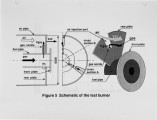| OCR Text |
Show the fuel pipe. The fuel pipe leads to three gas nozzles located just behind the respective air injection ports. Fuel gas is injected from the gas nozzles in the direction normal to the air flow just before the combustion air passes through the air injection port. 4.2 Performance of the test burner generating lifted flames Figure 6 shows the effect of excess air ratio on NOx and CO emissions for the generic test burner and the TPM burner. The air injection velocity of 30 m/s was selected for the TPM burner. Fuel input was maintained at Ip=480 kW. Over the entire range of excess air ratio used, the test burner generated lifted blue diffusion flames not stabilized at the burner plate. Although lifted, the flames ignited steadily without blowing off. Compared with the TPM burner that showed 27 ppm, the generic test burner demonstrated substantially low NOx of 14 ppm (0% 02) at the excess air ratio 1.1 without CO emission. Compared with the original TPM burner with Yair of 15 mIs, the generic test burner achieved as low as one quarter of the NOx emission. The lifted flame combustion maximizing the effect of self-induced EGR led to substantial NOx reduction without causing an increase in CO emission. 4.3 Low NOx characteristics of lifted flames To clarify the mechanism of the lifted flame combustion, the study investigated the effect of process parameters such as the velocity of combustion air and fuel gas. Two levels of fuel gas injection velocity (94 and 141 m/s) were selected and the air injection velocity was varied. Figure 7 shows the effect of t/J =VairNgas, the velocity ratio of air to gas, on NOx emission at the fuel input Ip of 480 kWand the excess air ratio A of 1.1. At t/J =0.13, NOx was as high as 34 ppm (0% 0) with flames stabilized at the air injection ports. As t/J increased to 0.2, flames started to be lifted and NOx dropped drastically down to less than 20 ppm. At t/J =0. 36, NOx emission of as low as 18 ppm (0% 02) was observed. The ratio of air to gas velocity t/J was thus shown to be responsible for generating lifted flames. With t/J larger than a certain threshold value, the generic burner generated lifted flames, leading to remarkably low NOx emission. |























